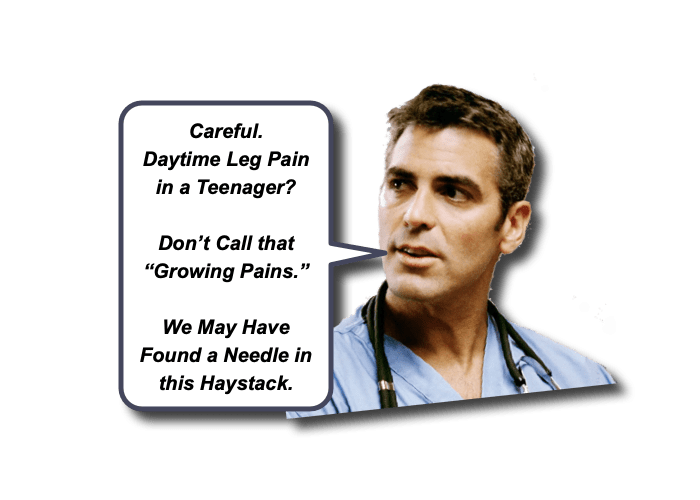Ewing Sarcoma

Many times providers convey to me that their greatest concerns come from the thought of having to care for the critically ill pediatric patient. Unquestionably, this patient deserves a high level of respect and is why we have an entire section of delicious Morsels dedicated to “Critical Care.” I will contend, however, that the child with a relatively minor complaint who actually has an ominous condition deserves as much respect. We have covered many concerning conditions that may masquerade as minor issues (ie, Needles in Haystacks, like Inborn Errors of Metabolism). Let’s expand on one of those issues – “Growing Pains.” While benign causes of “growing pains” do occur in children, let’s not be too cavalier and overlook the red flags for problematic conditions like Ewing Sarcoma:
Ewing Sarcoma: Basics
The 2nd most common bone tumor in children and adolescents. [Eaton, 2021; Grunewald, 2018]
- ~1.5 cases per million children and adolescents/young adults.
- Peak incidence is at 15 years of age.
- Osteosarcoma is the most common.
Originates in bone and soft tissues. [Eaton, 2021; Grunewald, 2018]
- Most common bony locations:
- Lower Extremities (Femur and Tibia)
- Pelvis
- Ribs
- Most common soft tissue locations:
- Trunk – thoracic cage, pleural cavities
- Cervical muscles
- Extremities – gluteal muscle
Metastases, unfortunately, can occur. [Eaton, 2021; Grunewald, 2018]
- Most often found in Lung, Bone, and Bone Marrow.
- Seen in up to 25% of cases at time of diagnosis.
It is well characterized [Grunewald, 2018]
- Histologically, it is a small round cell sarcoma.
- There are other “Ewing-like sarcomas” that are morphologically similar, but…
- Genetically, Ewing sarcoma has SPECIFIC chromosomal translocations
- Pathognomonic FET-ETS gene fusions.
- (I won’t try to restate what this actually means… but it leads to aberrant transcription factors and deregulation of hundreds of other genes).
- Ewing-like sarcomas do not match this genetic characterization.
Long-Term Survival [Grunewald, 2018]
- There are proven and effective strategies for localized disease.
- 5 year survival is ~70-80%
- Pelvic tumors lead to worse prognosis.
- Those with metastatic disease or relapsing disease have low survival rates.
- Survival is < 30%.
- Pulmonary involvement also has a low survival of ~50%.
- Early detection of Ewing sarcoma may be helpful – and is why we are taking about it now.
Ewing Sarcoma: Evaluation
Presentation of Ewing Sarcoma [Grunewald, 2018]
- May present with Localized Disease or Overt Metastases. [Grunewald, 2018]
- May also present with pathologic fractures (more likely with larger tumors).
- 6% of patients will present with spinal disease, so cord compression is of concern as well.
- Those on chemotherapy can also present with various therapy-related complications.
- Majority patients complain of localized pain. [Grunewald, 2018]
- Intermittent
- Worsens over time
- Often with Daytime pain… although sometimes is nocturnal.
- Often mistaken for “growing pains”
- May be attributed to “muscle pain or strains.”
- Diagnosis is often delayed 3-9 months.
- A substantial number of patients will develop a palpable soft-tissue mass. [Grunewald, 2018]
- May not be easily noticed in those with pelvic, femoral, or chest wall tumors.
- Pain without an adequate causal event or pain lasting > 1 month warrants concern and investigation. [Grunewald, 2018]
Initial workup of suspected Ewing Sarcoma [Grunewald, 2018]
- Thorough History (of course), including Family history (since this has a strong genetic component).
- Labs
- No blood test is diagnostic at this time.
- LDH is may be elevated and correlates with tumor burden.
- Imaging
- Plain radiographs
- CT of the Lung
- Additional imaging, including MRIs will be used for staging.
Management consists of multimodal strategies. [Grunewald, 2018]
- Multidisciplinary teams (including radiology, pathologists, surgeons, oncologists, orthopaedic surgeons, and specialized nurses) are required.
- Surgical resection and fancy pharmaceutical regimens will be employed.
Moral of the Morsel
- “Growing Pains” may be real, but it isn’t the cause of every pain.
- Pain that worsens over time is not consistent with a remote minor strain/sprain.
- A palpable mass? Well, that may also be Ewing sarcoma.

